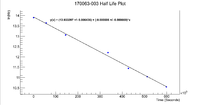Below is a table with thin windows, original windows, and expanded windows for the nickel on sample 170063. The thin window method can be found at LB Thesis Thin Window Analysis.
|
5/25/17 |
5/26/17 |
5/27/17 |
5/29/17 |
5/30/17 |
5/31/17 |
6/1/17 |
|
| Thin Window |
 |
 |
 |
 |
 |
 |

|
| Original Window |
 |
 |
 |
 |
 |
 |

|
| Original Background |
329.6 +/- 8.6 |
708.3 +/- 12.8 |
1611 +/- 19.9 |
247.4 +/- 7.5 |
721 +/- 13.1 |
424.8 +/- 9.9 |
215.4 +/- 7.0
|
| Integrated Background |
659.2 +/- 17.2 |
1416.6 +/- 25.6 |
3222 +/- 39.8 |
494.8 +/- 15 |
1442 +/- 26.2 |
849.6 +/- 19.8 |
430.8 +/- 14
|
| Signal in Thin Window |
52350 +/- 228.80 |
97860 +/- 312.83 |
118500 +/- 344.24 |
47420 +/- 217.76 |
73100 +/- 270.37 |
54930 +/- 234.37 |
33720 +/- 183.63
|
| Position on Detector A (cm) |
50 |
30 |
20 |
20 |
10 |
10 |
10
|
| Efficiency (Percent) |
0.017000 +/- 0.000002 |
0.042200 +/- 0.000005 |
0.084700 +/0.000007 |
0.084700 +/0.000007 |
0.310000 +/- 0.000003 |
0.310000 +/- 0.000003 |
0.310000 +/- 0.000003
|
| Signal in thin Window With Efficiency |
307941176.5 +/- 3864757.4 |
231895734.6 +/- 741812.3 |
139905549 +/- 406587.1067 |
55985832.4 +/- 257137.3 |
23580645.2 +/- 87216.4 |
17719354.8 +/- 75603. 4 |
10877419.4 +/- 59235.6
|
| Integrated Background with Efficiency |
3877647.1 +/- 101177.5 |
3372857.1 +/- 60953.7 |
3804014.2 +/- 46990.42 |
584179.5 +/- 17709.6 |
465161.3 +/- 8451.6 |
274064.5 +/- 6387.1 |
13897.7 +/- 4516.1
|
| Background Subtracted Signal |
304063529.4 +/- 3866081.6 |
228522877.5 +/- 744312.3 |
136101534.8 +/- 409293.5 |
55401652.9 +/- 257746.4 |
23115483.9 +/- 87624.9 |
17445290.3 +/- 75872.7 |
10863521.7 +/- 59407.5
|
| Runtime (s) |
301.337 |
301.322 |
327.734 |
300.228 |
272.845 |
300.691 |
306.858
|
| Rate (Hz) |
[math] 1.009048 \times 10^6 \pm 1.2829 \times 10^4 [/math] |
[math]7.58401 \times 10^5 \pm 2.470 \times 10^3[/math] |
[math] 4.15280 \times 10^5 \pm 1.248 \times 10^3 [/math] |
[math]1.84531 \times 10^5 \pm 8.58 \times 10^2 [/math] |
[math] 8.4720 \times 10^4 \pm 3.2115 \times 10^2[/math] |
[math] 5.8017 \times 10^4 \pm 2.5233 \times 10^2 [/math] |
[math] 3.5402 \times 10^4 \pm 1.9360 \times 10^2 [/math]
|
| True Rate (Integral Method) (Hz) |
[math]1.040020 \times 10^6 \pm 1.3222 \times 10^4 [/math] |
[math] 7.81679 \times 10^5 \pm 2.5458 \times 10^3[/math] |
[math] 4.29155 \times 10^5 \pm 1.290 \times 10^3 [/math] |
[math] 1.90175 \times 10^5 \pm 8.8425 \times 10^2 [/math] |
[math] 8.7072 \times 10^4 \pm 3.29 \times 10^2 [/math] |
[math] 5.9793 \times 10^4 \pm 2.59 \times 10^2 [/math] |
[math] 3.6508 \times 10^4 \pm 2.00 \times 10^2 [/math]
|
| Number of Entries in Histogram |
566090 |
1015134 |
1428804 |
541498 |
984165 |
761238 |
494039
|
| [math] \frac{Entries}{Runtime} [/math] |
1878.59 |
3368.93 |
4359.64 |
1803.62 |
3607.05 |
2531.63 |
1609.99
|
| Percent Dead |
3.95 +/- 0.42 |
6.59 +/- 0.43 |
9.09 +/- 0.60 |
3.95 +/- 0.42 |
6.59 +/- 0.43 |
5.06 +/- 0.39 |
3.06 +/- 0.3
|
| True Rate (Hz) |
[math] 1.082790 \times 10^6 \pm 1.4557 \times 10^4 [/math] |
[math] 8.36825 \times 10^5 \pm 4.764 \times 10^3 [/math] |
[math] 4.72065 \times 10^5 \pm 3.332 \times 10^3[/math] |
[math] 1.97995 \times 10^5 \pm 1.322 \times 10^3[/math] |
[math] 9.3214 \times 10^4 \pm 5.59 \times 10^2[/math] |
[math] 6.2979 \times 10^4 \pm 3.62 \times 10^2 [/math] |
[math] 3.7660 \times 10^4 \pm 2.33 \times 10^2 [/math]
|
| .dat file entry |
13.90 +/- 0.01 |
13.64 +/- 0.01 |
13.06 +/- 0.01 |
12.20 +/- 0.01 |
11.44 +/- 0.01 |
11.04 +/- 0.01 |
10.54 +/- 0.01
|
Below is a plot that was made to help find the half life and the initial activity of the sample

from here we can see that
[math] Slope = 5.63921 \times 10^{-6} \pm 1.75557 \times 10^{-8} [/math]
and the intercept is given by
[math] 13.9333 \pm 0.00643596 [/math]
By exponentiating the intercept, we can find the activity of the nickel foil at the time of the first measurement, which is
[math] 1.125007 \times 10^6 \pm 7.240 \times 10^3 [/math]
Now note that this measurement was taken 8 minutes after the selenium samples were measured. So we must correct the activity back 8 minutes.
[math] A_0 = 1.125007 \times 10^6 \times e^(5.40845 \times 10^{-6} \times \480) = 1.127931 \times 10^6 Hz [/math]
[math] \sigma_{A_0} = 7240 \times e^(5.40845 \times 10^{-6} \times 480) = 7258.82 Hz [/math]














